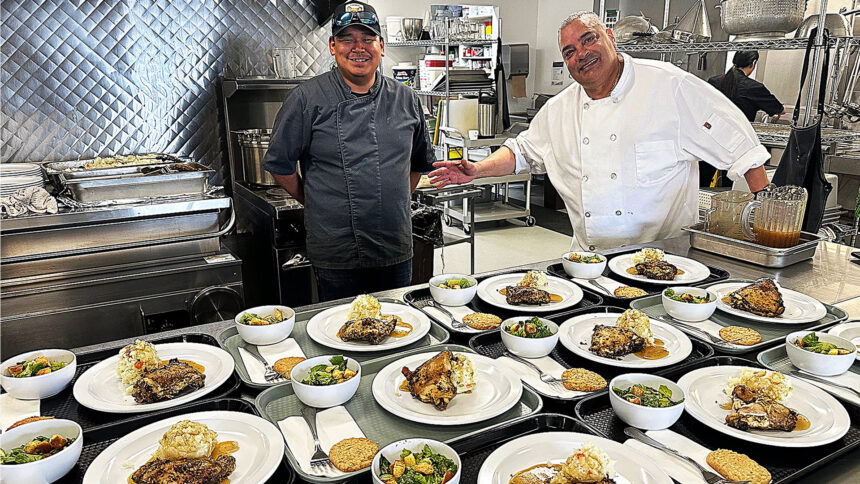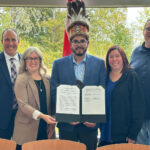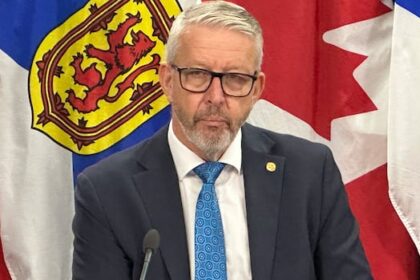The head of a foundation that helps children in Nunavut says food security issue in the territory is in crisis and people there are resorting to “desperate measures” to get by and feed their children. “We are in the worst food-security crisis I have seen,” said Dr. Sindu Govindapillai, executive director of the Arctic Children and Youth Foundation and a pediatrician working in the community. “Our patients, our clients, are going through desperate measures to get food for their children. We have heard from our clients that they have had to travel long distances to line up at the food banks. And sometimes, unfortunately, they have to be turned away because we all have limits as to what we can do.” Govindapillai said her clients have been posting photos of empty fridges and cupboards to Facebook, asking for help with food, diapers, and baby wipes. “Non-profits like ours are at a breaking point,” she said. “There are only so many gift certificates we can give out. There are only a number of formulas, diapers, and wipes that have been given out by Family Services. “Qajuqturvik (Qajuqturvik Community Food Centre) has a limit as to the number of meals they can serve a day. And when the population’s food insecurity is 79 per cent for young children, our piecemeal efforts, as much as it seems like we are making a difference, is not making a dent in this issue.” Five year graph showing demand for meals at Qajuqturvik Community Food Centre. Photo: QCFC Govindapillai reported family doctors had begun prescribing meal-replacement drinks like Ensure and Boost to undernourished adults, while some pediatrician colleagues have begun prescribing formula for babies simply because of hunger, which some Nunavut physicians have begun to diagnose as a medical condition. Joseph Murdoch-Flowers, executive director of the Qajuqturvik Community Food Centre, or QCFC, said the centre served 639 lunches on a single day last week. “In a town of 8,000 people, that represents eight per cent of the population and that’s just for lunch,” he said. “We know that our numbers have steadily increased over the years.” From 58,000 meals in 2022, the demand jumped to 67,00 in 2023, then 70,000 in 2024. “And this year alone,” Murdoch-Flowers said, “we’re not done September yet. We’re at 62,179 meals and that doesn’t count what we just put out today at lunchtime. We’re going to smash through our record in October. “And we feel the crushing demand of this in our dining room and in our kitchen.” Murdoch-Flowers reported Qajuqturvik has responded to demand by adding more seats to the dining room, buying additional equipment and hiring more staff to plan, prepare, and serve meals, and clean up afterward. “We see the dining room fill up immediately, every day at 11:30,” he said. “This dining room is packed full of people. The line immediately comes in, goes out the door, and we have 64 seats in here, full, with a line of people waiting to come in and get the beautiful food that our staff put out every day. So we know that 600 meals is still not enough.” Read more: Charity in Iqaluit has big plans to fight food insecurity in the city First annual poverty report card reveals harsh realities faced by Nunavut’s most vulnerable Hunger occurs at breakfast and at supper, on weekends and on holidays, Murdoch-Flowers said. For that reason, he argued, it was now time for Qajuqturvik to shift to providing three meals a day, every day of the year. In order to do that, he said he’ll need to double his paid kitchen staff. While he expressed gratitude for the many volunteers who’ve worked hard to keep their neighbours fed, Murdoch-Flowers said the need is so great that only well-compensated salaried employees can meet it. “I’ve had some initial discussions with the City of Iqaluit and they are on standby and ready to support us in our request for emergency funding for more money to bring in that staff and to bring in those resources that we need,” he said. “I’m going to need to buy a lot more product and I’m going to need to store that product somewhere, because we are bursting out seams in every way.” While he expressed gratitude for the Anglican Diocese of the Arctic for providing a space in which Qajuqturvik could operate, the organization would ultimately require a purpose-built space to handle demand. At a news conference on Sept. 17, Murdoch-Flowers choked up and had to pause for a moment as he saluted his staff. “You can’t meet the demand with what we are getting by on,” he said. “I’ve told my staff, to me, they’re heroes. Every gesture that they do in this job is a daily expression of their care and their commitment to this community and our collective wellness to support them.” Govindapillai blamed the end of the Hamlet food-voucher program for the current food-security crisis. That voucher program was part of the Inuit Child First Initiative from Indigenous Services Canada (ISC), which discontinued it in April of 2025. Nunatsiaq News reported that ISC program officer Andrew Ouellette argued in a letter that month that it would not approve funding for universal food voucher programs “based on its analysis of legal obligations related to substantive equality under the Inuit Child First Initiative.” Chart showing increasing number of visitors to Qajuqturvik Community Food Centre and the increasing number of meals served. Photo: QCFC The Hamlet food-voucher program gave families $250 per child per month for formula, diapers, and wipes, Govindapillai said, all of which disappeared overnight when the program ended. At the same time, she noted, there has been a 24 per cent increase in food costs, at a time when neither income-support payments nor salaries increased by 24 per cent. “The gap between the poverty line in Nunavut is so far from the welfare income that it is laughable,” Govindapilla argued. “The poverty line, per our most recent market basket measure in the Qikiqtaaluk region [of Nunavut], is $83,000. Welfare income is $36,000.” That means every month, families on income-support are always more than 50 per cent away from living what Govindapillai called, “a dignified life.” “There is no non-profit,” she said, “no matter how good we are, no matter how passionate we are, that can get people 50 per cent of the way to the poverty line.” The time was long past for working groups and more research, she said. Her arguments were supported by a presentation at the news conference from Dr. Sappho Gilbert from Harvard University’s T.H. Chan School of Public Health and the Harvard Kennedy School’s Arctic Initiative. During that presentation, Gilbert noted that wherever people receive their money in Nunavut, most spend it quickly on groceries. “Sales of both groceries overall, and in particular of meat and meat products, go up about a third on Canada Child Benefit Day,” Gilbert said, “and even higher on federally renewed payday. Relative to total grocery sales, it seems that meat and meat product sales are going up even more than just general spending at the store. We know that when money comes in, people are going and buying food with it.” As well, Gilbert noted, there is a strong culture of community sharing in Iqaluit. Whenever money flows into community members, not only does food immediately begin to flow with it, but residents also feed their extended families and people in their sharing networks. There’s nowhere near as great a gap between the poverty line and income support in the Northwest Territories and the Yukon, Govindapillai noted. She took that as confirmation that Nunavut could do better provided the territory and the federal government make a serious effort to invest in feeding children. “Rather than bringing back the Hamlet Voucher Program, which did have its challenges,” she said, “what we’re advocating for is the increase in the [Nunavut Child Tax Benefit’s] minimum child benefit that will give people money to do what they want with it.” The Nunavut Child Tax Benefit currently gives roughly one cent per month to Nunavut residents making $30,000 per year, Govindapillai said. Yet a substantial increase to that program would be a strong correction for the current state of need. “We need to just listen to the researchers. It’s very clear. Give people money for food. When people have money, they use it for food. We need emergency financial assistance at the territorial level.” On Sept. 15, Rebecca Chartrand, the minister of Northern Affairs and the Canadian Northern Economic Development Agency, celebrated the federal Nutrition North program in the House of Commons. “Nutrition North is showing real progress, with results that are reaching more northerners every year,” she argued. “In its first year, more than 15,000 harvesters were supported, with hundreds of hunts and over 700 food-sharing initiatives, from Nain, Nunatsiavut, to Old Crow, Yukon, showing the program’s reach across the north. In Nunavut, the price of flour in Rankin Inlet has dropped by more than 65 per cent, and in Igloolik, a dozen eggs, which was once nearly $10, is now just five dollars.” No one at the press conference mentioned Nutrition North as a factor in easing food insecurity in Iqaluit. APTN News contacted Chartrand’s office and requested an interview, but we did not receive a response prior to publication. Continue Reading
Centre in Iqaluit says territory is in a food crisis

Leave a Comment










